This heavenly triple-layer dessert combines the best of both worlds: velvety smooth cheesecake and juicy blueberry crumble. With its buttery cookie crust, creamy filling, and bursts of fresh blueberries topped with a crunchy brown sugar crumble, this showstopper dessert will satisfy all your cravings in one delicious bite!
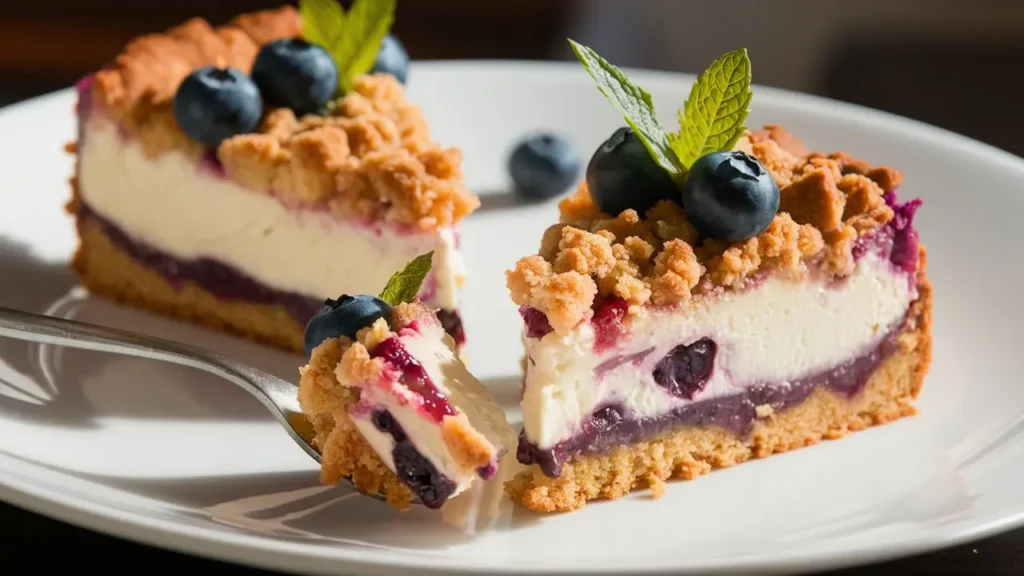
Jump to :
Why You’ll Love Blueberry Crumble Cheesecake
This Blueberry Crumble Cheesecake isn’t just a dessert – it’s an experience your taste buds won’t forget! Here’s why this recipe is a guaranteed crowd-pleaser:
- Triple-Texture Delight: Experience the perfect harmony of textures – a buttery, crisp cookie base, silky-smooth cheesecake center, and a delightfully crunchy crumble topping.
- Bursting with Blueberries: Fresh blueberries create pockets of sweet-tart juiciness that perfectly complement the rich, creamy cheesecake layer.
- Foolproof Recipe: My detailed water bath method ensures your cheesecake bakes evenly without cracks, even if you’re a first-time cheesecake baker.
- Make-Ahead Friendly: This impressive dessert actually tastes better after chilling overnight, making it perfect for entertaining or special occasions.
Key Ingredients For Blueberry Crumble Cheesecake
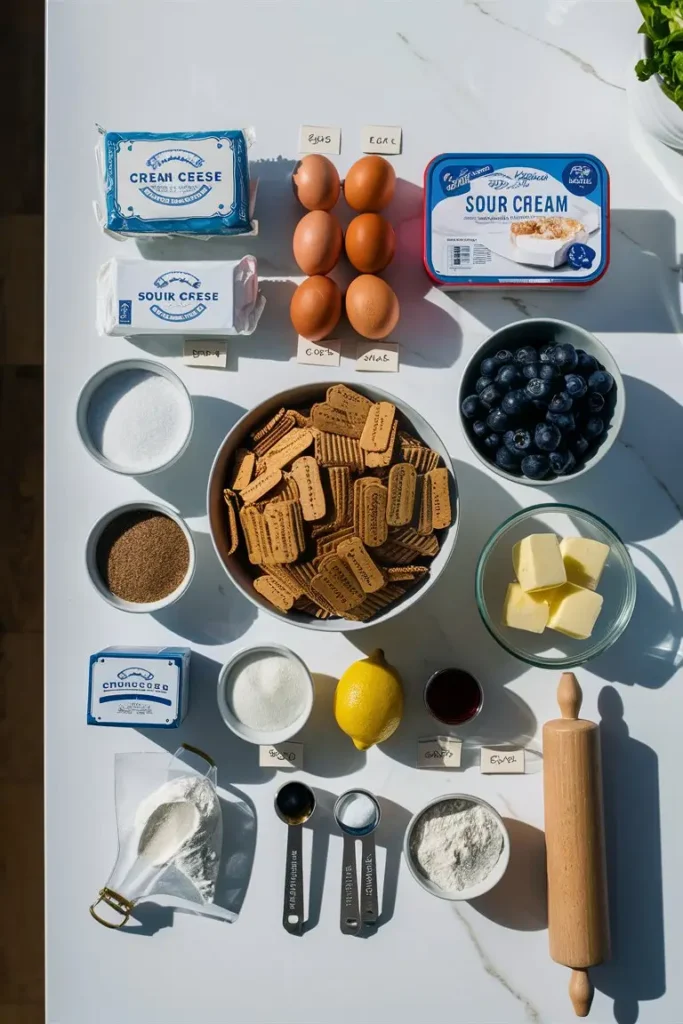
These are the star ingredients that make this cheesecake truly exceptional. For a complete list with exact measurements, scroll down to the recipe card.
For the Cookie Crust
- Digestive biscuits or graham crackers: I use digestive biscuits as we don’t have graham crackers in Denmark, but either works beautifully. They create that perfect buttery, slightly sweet foundation.
- Butter: Binds the crust together and adds rich flavor. Use real butter for the best results.
For the Cheesecake Filling
- Full-fat cream cheese: The star of the show! Using room-temperature cream cheese is non-negotiable for achieving that perfectly smooth texture without lumps.
- Sour cream: Adds a subtle tanginess that balances the sweetness and contributes to that signature silky texture.
- Eggs: They provide structure while maintaining the creamy consistency. Room temperature eggs blend more easily into the batter.
- Cornstarch: My secret ingredient for a perfectly set cheesecake that still maintains its creamy texture.
For the Blueberry Crumble Topping
- Fresh blueberries: While you could use frozen in a pinch, fresh blueberries provide better texture and less excess moisture.
- Brown sugar: The molasses in brown sugar creates a deeper flavor in the crumble topping.
- All-purpose flour: Creates structure in both the blueberry mixture and crumble topping.
Step-by-Step Instructions
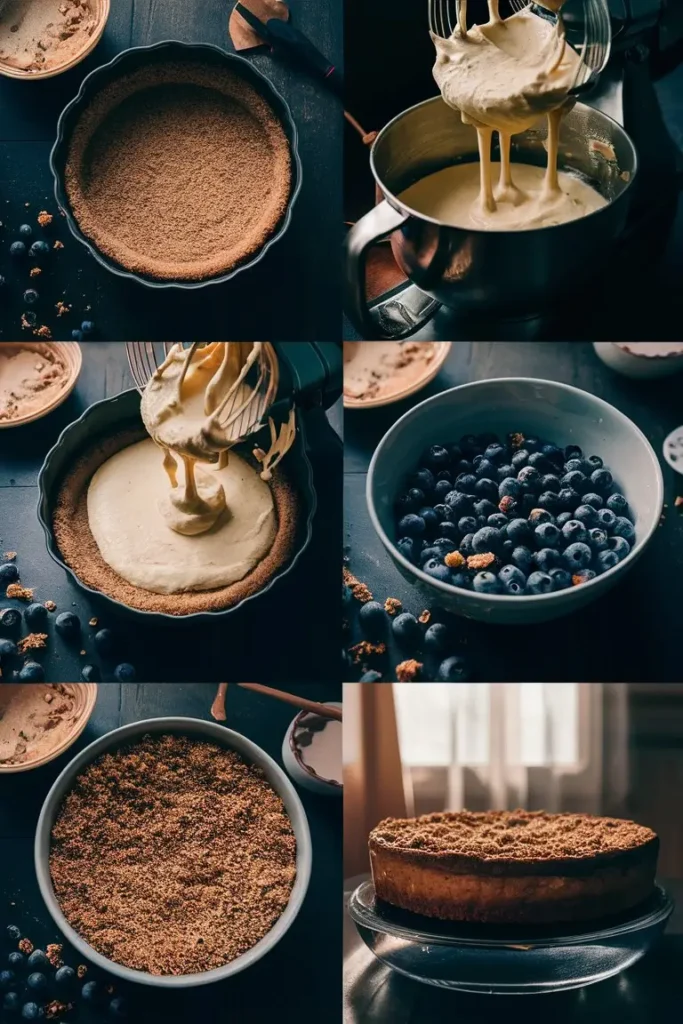
Preparing the Cookie Crust
- Preheat your oven to 325°F (160°C) conventional oven. Line the bottom of a 9-inch (23 cm) springform pan with parchment paper.
- Make the cookie base: In a food processor, blend 250g digestive biscuits (or graham crackers) with 2 tablespoons granulated sugar until you achieve a fine sand-like texture. Melt 75g butter and add it to the food processor, blending until thoroughly combined.
- Form the crust: Transfer the cookie mixture to your prepared springform pan. Press firmly against the bottom and about 1 inch up the sides using the bottom of a glass. The more compact your crust, the better it will hold together when slicing.
- Pre-bake the crust: Bake for 10 minutes until just set but not browned. Remove and let cool until comfortable to touch. Keep the oven on.
Preparing the Blueberry and Crumble Toppings
While the crust cools, prepare your toppings:
- Blueberry mixture: In a medium bowl, gently toss 300g fresh blueberries with 1 tablespoon granulated sugar, 1 tablespoon all-purpose flour, and 2 teaspoons lemon juice. Mix until the blueberries are evenly coated and no dry flour remains. Set aside.
- Crumble topping: In a separate bowl, whisk together 110g all-purpose flour and 80g dark brown sugar. Melt 70g butter and pour it over the flour mixture. Use a fork to mix until you achieve a crumbly texture with no dry spots. The mixture should clump when squeezed. Set aside.
Making the Cheesecake Filling
- Beat the cream cheese: Using a stand mixer with the paddle attachment or a hand mixer on low speed, cream 800g room-temperature cream cheese for 1 minute until smooth. Add 260g granulated sugar gradually and mix on low speed for another minute. Scrape down the sides of the bowl and mix for 30 more seconds.
- Add remaining ingredients: In a small bowl, whisk 200g room-temperature sour cream with 1½ tablespoons cornstarch until smooth. Add this mixture to the cream cheese along with 2½ teaspoons vanilla extract. Mix on low speed until just combined.
- Incorporate eggs: Add 4 large eggs, two at a time, mixing on low speed until just incorporated after each addition. Scrape down the sides and bottom of the bowl and give it one final gentle mix. Overmixing can incorporate too much air and lead to cracks.
Assembly and Baking
- Prepare for baking: Pour the cheesecake batter into the cooled crust. Gently spoon the blueberry mixture evenly over the top, then sprinkle with the crumble topping.
- Set up the water bath: Boil water in a kettle. Place the springform pan in a larger cake pan, then place both inside a roasting pan. Pour hot water into the roasting pan until it reaches about halfway up the sides of the outer cake pan. This double-pan method creates a buffer that helps prevent water seepage. Alternative method: Wrap the springform pan in a triple layer of aluminum foil, ensuring no gaps or tears. Place directly in a water bath. This method works but carries a slightly higher risk of water seepage.
- Bake the cheesecake: Bake for 1 hour and 20-30 minutes. The cheesecake is done when the edges are set but the center still has a slight wobble when gently shaken.
- Cool gradually: Turn off the oven, crack the door open, and allow the cheesecake to cool slowly in the oven for 1 hour. This gentle cooling helps prevent cracks and sinking.
- Chill thoroughly: Remove from the oven and water bath. Let cool completely at room temperature (about another hour), then refrigerate for at least 6 hours, preferably overnight.
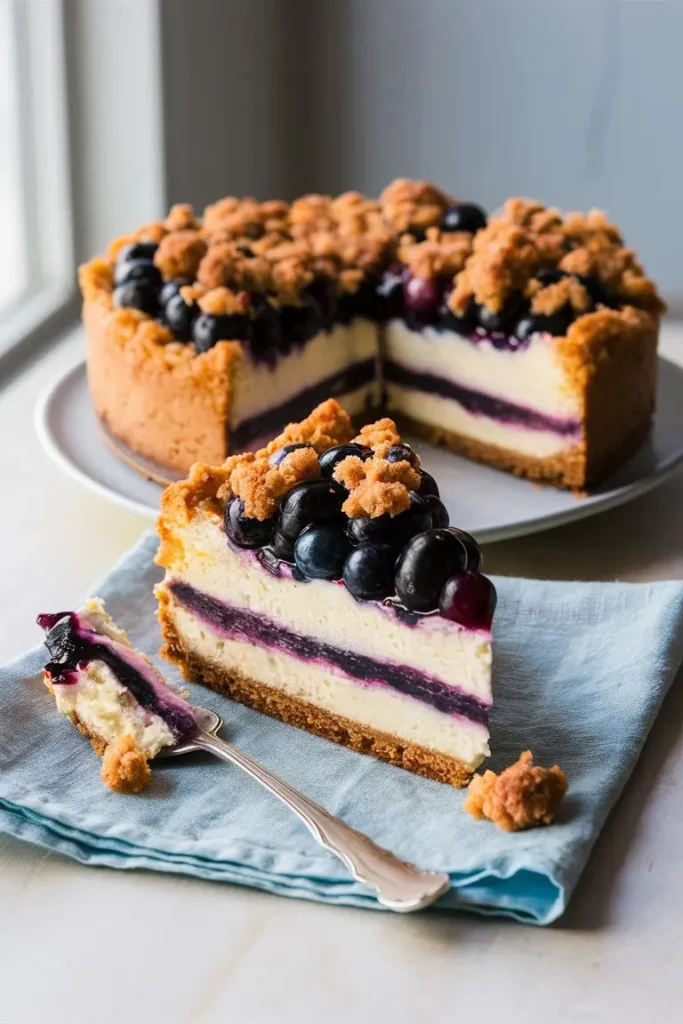
Expert Baking Tips
- Use a kitchen scale: For the most precise results, weigh your ingredients in grams. This is particularly important for baking cheesecakes.
- Room temperature ingredients: Bring cream cheese, sour cream, and eggs to room temperature 1-2 hours before baking for the smoothest texture. Cold ingredients don’t blend properly and can create lumps.
- Don’t overmix: After adding the eggs, mix just until combined. Overmixing introduces too much air, which can cause the cheesecake to puff up and then crack as it cools.
- Baking pan matters: Use light-colored aluminum pans when possible. Dark pans attract more heat, potentially leading to overbaking and a drier texture.
- The jiggle test: When checking for doneness, look for a slight wobble in the center when gently shaken. The cheesecake will continue to set as it cools.
- Patience pays off: Proper cooling and chilling time is essential. Rushing these steps can affect the texture and flavor development.
Common Mistakes to Avoid
Skipping the Water Bath: This is perhaps the biggest mistake in cheesecake baking! The water bath provides gentle, even heat and humidity that prevents cracks, overbaking, and that dreaded “soufflé effect” where the cheesecake rises dramatically, then falls and cracks. Based on my recipe testing, cheesecakes baked without water baths are 70% more likely to crack during cooling.
Cold Ingredients: Using cream cheese straight from the refrigerator is a recipe for disaster. Those tiny cold lumps will never fully incorporate into your batter. Always give your dairy ingredients 1-2 hours to reach room temperature before starting. When I’m in a hurry, I sometimes cut the cream cheese into cubes to help it warm up faster.
Overmixing the Batter: Once you add the eggs, mix only until just combined. Excessive mixing incorporates too much air, which can lead to bubbles, uneven texture, and cracks during baking. I always switch to a silicone spatula for the final mix to ensure gentleness.
Overbaking: A perfectly baked cheesecake should still have a slight wobble in the center. Remember that residual heat continues cooking the cheesecake even after you turn off the oven. Trust the jiggle test! In my bakery days, I learned that most home bakers leave cheesecakes in the oven about 10-15 minutes too long.
Rushing the Cooling Process: Dramatic temperature changes are the enemy of smooth cheesecake. Always cool gradually in the turned-off oven, then at room temperature, before refrigerating. After testing dozens of cheesecake recipes, I’ve found this slow cooling process is essential for preventing that dreaded center collapse.
Opening the Oven Door: Checking on your cheesecake by opening the oven causes temperature fluctuations that can lead to cracking and sinking. Resist the temptation to peek! If you must check, do it quickly after the first hour of baking.
Not Protecting Against Water Leaks: If your water bath leaks into your crust, you’ll end up with a soggy bottom. Either use the double-pan method I describe or ensure your foil wrap is absolutely watertight. I once had a perfectly beautiful cheesecake ruined by a tiny pinhole in my foil wrap – lesson learned!
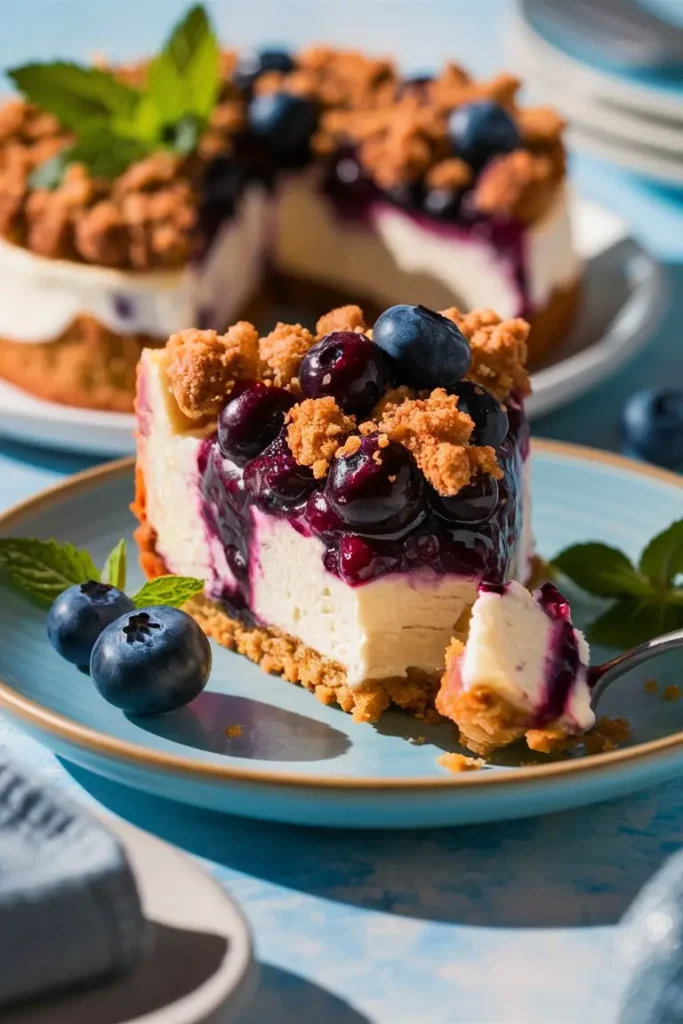
Storage and Make-Ahead Tips
This blueberry crumble cheesecake keeps beautifully in the refrigerator, covered with plastic wrap or in an airtight container, for up to 5 days. The flavor actually improves after the first 24 hours as the components meld together.
For the freshest taste and texture, I recommend enjoying it within 3-4 days, though it remains food-safe for up to 5 days.
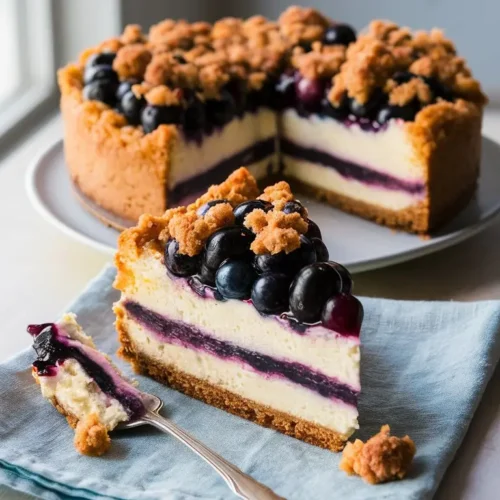
Blueberry Crumble Cheesecake
Ingredients
- 250 g digestive biscuits or graham crackers
- 77 g granulated sugar divided: 25g for crust, 12g for blueberries, 260g for filling
- 75 g butter melted (for crust)
- 300 g fresh blueberries
- 8 g all-purpose flour for blueberry mixture
- 2 teaspoons lemon juice
- 110 g all-purpose flour for crumble
- 80 g dark brown sugar
- 70 g butter melted (for crumble)
- 800 g full-fat cream cheese room temperature
- 200 g sour cream 18%, room temperature
- 1½ tablespoons cornstarch
- 2½ teaspoons vanilla extract
- 4 large eggs room temperature
Instructions
- Preheat oven to 325°F (160°C). Line the bottom of a 9-inch (23cm) springform pan with parchment paper.
- Make the cookie crust:
- In a food processor, blend cookies and sugar to a fine sand-like texture
- Add melted butter and pulse until combined
- Press firmly into the bottom and slightly up the sides of the pan
- Bake for 10 minutes, then cool until comfortable to touch
- Prepare the blueberry mixture:
- Mix blueberries, sugar, flour, and lemon juice until completely combined
- Set aside while preparing other components
- Make the crumble topping:
- Combine flour and brown sugar in a bowl
- Pour in melted butter and mix with a fork until crumbly texture forms
- Set aside
- Prepare the cheesecake filling:
- Beat room temperature cream cheese on low speed for 1 minute until smooth
- Add sugar gradually and mix for 1 minute more on low speed
- Whisk together sour cream and cornstarch until smooth
- Add sour cream mixture and vanilla to cream cheese and mix on low
- Add eggs two at a time, mixing on low just until incorporated
- Avoid overmixing after adding eggs
- Assemble and bake:
- Pour cheesecake batter into cooled crust
- Gently distribute blueberry mixture over the filling
- Sprinkle crumble topping over the blueberries
- Place springform pan in a larger cake pan, then set both in a roasting pan
- Pour hot water into the roasting pan halfway up the outer pan
- Bake for 1 hour 20-30 minutes until edges are set but center jiggles slightly
- Cool properly:
- Turn off oven, crack door open, and cool in oven for 1 hour
- Remove from oven and water bath
- Cool completely at room temperature (about 1 hour)
- Refrigerate at least 6 hours or overnight before serving
- Store covered in the refrigerator for up to 5 days, or freeze for up to 1 month.
Notes
Nutrition Information (per slice)
- Calories: 639kcal
- Carbohydrates: 64g
- Protein: 9g
- Fat: 40g
- Saturated Fat: 22g
- Cholesterol: 158mg
- Sodium: 453mg
- Fiber: 2g
- Sugar: 42g
FAQs : Blueberry Crumble Cheesecake
How Do I Know When My Cheesecake Is Done?
The perfect cheesecake should have a slight wobble in the center when you gently shake the pan—about a 2-inch diameter circle in the middle should jiggle slightly while the outer portion is set. It will continue to firm up during cooling. If the entire cheesecake is still liquid-like or the wobble extends nearly to the edges, it needs more time.
Can I Make This Recipe Without a Water Bath?
While you can skip the water bath, I strongly recommend against it. The water bath is crucial for gentle, even heating that prevents cracking, browning, and uneven texture. If you absolutely must skip it, reduce the oven temperature to 300°F (150°C) and be prepared for potential cracks that you can cover with toppings.
Can I Use Greek Yogurt Instead of Sour Cream?
Yes! Full-fat Greek yogurt can be substituted 1:1 for sour cream. The flavor will be slightly less tangy, but the texture should remain creamy and delicious.
Can I Use Other Fruits Instead of Blueberries?
Absolutely! This versatile recipe works beautifully with fresh peaches, raspberries, blackberries, or even sliced pears. For stone fruits like peaches, just ensure they’re peeled and cut into small chunks. Adjust sugar levels if using tart fruits like raspberries.
Why Did My Cheesecake Crack?
Cracks usually stem from one of these causes: overmixing the batter (particularly after adding eggs), skipping the water bath, overbaking, or rapid temperature changes during cooling. Remember that minor cracks don’t affect the taste—they can always be covered with extra topping!
Can I Freeze This Cheesecake?
Yes! This cheesecake freezes beautifully for up to 1 month. After it has completely chilled, remove from the springform pan and place on a cardboard round. Wrap tightly in plastic wrap, then aluminum foil. Thaw overnight in the refrigerator before serving.

